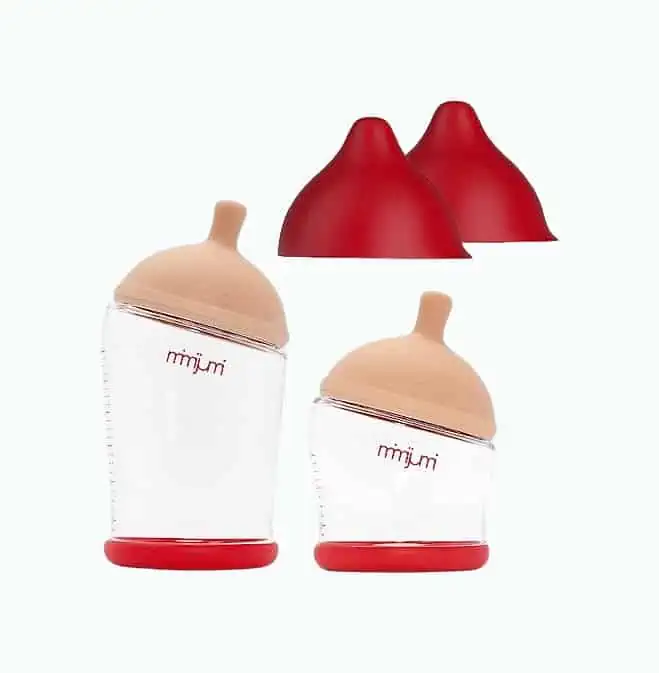Some bottles mimic the experience of breastfeeding, such as this Mimijumi bottle.
We’ve put together this review to help you decide if this bottle is the solution to your fears.
Product Overview

The top of the Mimijumi bottle is a flesh-colored dome that looks very similar to a mother’s breast. In theory, this should work hand-in-hand with breastfeeding or transitioning from breastfeeding to a bottle.
This product has an improved nipple design from earlier versions. If you order the Very Hungry bottle, you get an 8-ounce bottle, a cap, and a screw-on slow-flow nipple.
Pros
- Both parts are BPA- and latex-free.
- You can open and close this bottle using only one hand.
- Integrated venting helps reduce or possibly prevent colic.
Cons
- Although the nipple is slow flow, some users have reported the milk coming out too fast for a newborn.
- Expensive for one bottle, especially if you need to purchase several.
Key Features and Benefits
- It has a skid-free base and a screw-on nipple. While many bottles have a lid that secures the nipple in place – on this one, the nipple just screws right onto the bottle.
- The dome-shaped top makes latching and feeding closer to what your baby would experience with breastfeeding. The flesh-colored nipple is unique – you don’t see that with any other baby bottles on the market. Plus, your baby will have to suck on the nipple to get milk to come out – it isn’t a gravity-fed bottle like many other traditional bottles on the market.
- You can buy replacement nipples, and they come in two flow rates – slow and medium.
- If your baby is having problems with colic, this unit has integrated venting to help with that.
- This bottle has a wide mouth that makes it easy to clean. You won’t have any problem getting bottle brushes to fit in this bottle, and it has no weird angles that will make it hard to clean.
- It can be washed in the top rack of the dishwasher.
- It can only fit in bottle warmers that are made for wide-mouth bottles.
- These bottles can be used for formula-fed babies as well as breastfed babies.
Ease of Use
The skid-free base is a welcome addition to any bottle. I’ve spilled far too many bottles trying to screw the nipple on with one hand while holding my impatient baby with the other arm. Because the skid-free base lends some stability to the bottle when it’s sitting on the counter, you truly can prepare this bottle with only one hand.
Something else moms might appreciate about this bottle is that since this nipple screws right onto the bottle and there’s no additional lid in the equation, you won’t have that problem of trying to find the perfect seal so it doesn’t leak.
Build Quality
Although it is meant to feel and look like a real breast, the nipple on this bottle is longer than a human nipple actually would be. That can cause an issue for smaller babies who might gag when they try to feed from this bottle.
This bottle is very rigid – it isn’t nearly as soft as a human breast, which is fine, but your baby may notice the difference. The cap to the bottle doesn’t seem to fit very well and regularly falls off – perhaps that’s because there isn’t a traditional lid for it to snap onto.
How Do They Compare?
Let’s compare the Mimijumi Very Hungry Baby to some other popular bottles on the market
Tommee Tippee Closer to Nature Bottles
Like the Mimijumi bottle, this bottle can help babies with breast and bottle confusion. Because of the softer nipple it has, the Closer to Nature bottle is better suited for newborns. With its firm nipple, the Mimijumi can better serve older babies.
Comotomo Natural Feel Baby Bottle, 8 Ounces
These bottles are soft and squeezable, much like a breast. That may please moms who want the bottle to seem breast-like for their babies. Moms who like the feel of a traditional bottle would likely prefer the much firmer Mimijumi.
Medela Calma Breastmilk Feeding Bottles
The Calma makes a baby work to get any milk – your baby must first create a vacuum with his mouth to get the milk flowing. Moms who want to ensure there’s absolutely no breast versus bottle confusion may like that. Moms who have a hard time getting babies to take anything other than the breast may like the realistic-colored nipple on the Mimijumi. Some babies who are used to the breast may be fooled by the appearance of the Mimijumi.
Who Should Buy These Bottles?
Avoiding confusion between the breast and bottle is a big priority for moms who don’t want bottle feeding to make a baby too lazy to breastfeed. This bottle helps with that problem.
Visually, it will appeal to breastfed babies because the dome very closely resembles a breast. Since the bottle won’t reward your baby by giving milk if she doesn’t make an effort, it won’t sabotage your goal of continuing to breastfeed your baby.
Because of the cost of this bottle, however, if I were you, I would only buy one at first to make sure your baby likes it.
What Should I Know Before Buying a Breastfeeding Bottle?
Using a bottle on a baby who is learning how to breastfeed can be tricky. If you aren’t careful in your bottle selection, you can undo all the progress you’ve made in your breastfeeding effort. Thankfully, there are some great bottle options out there for women who are concerned about this issue. These bottles have made it easier than ever for moms to make breastfeeding work in our busy lives.
If you plan never to leave your child’s side so he can have access to your breasts around the clock, you may be able to get by without buying any bottles. But for the rest of us, bottles are a good idea to supplement actual breastfeeding sessions.
Not only does it mean we can go to work and know our baby is still getting the nutrients she needs, but it also gives dads a chance to participate in the feedings. Dads sometimes feel sorry that they aren’t involved with the breastfeeding process (1), and bottle feeding a baby breast milk is the perfect solution for that problem.
But before you rush out and get the first breastfeeding bottle you see, you might want to compare their prices, what materials they’re made out of, and what ages they work best for.






